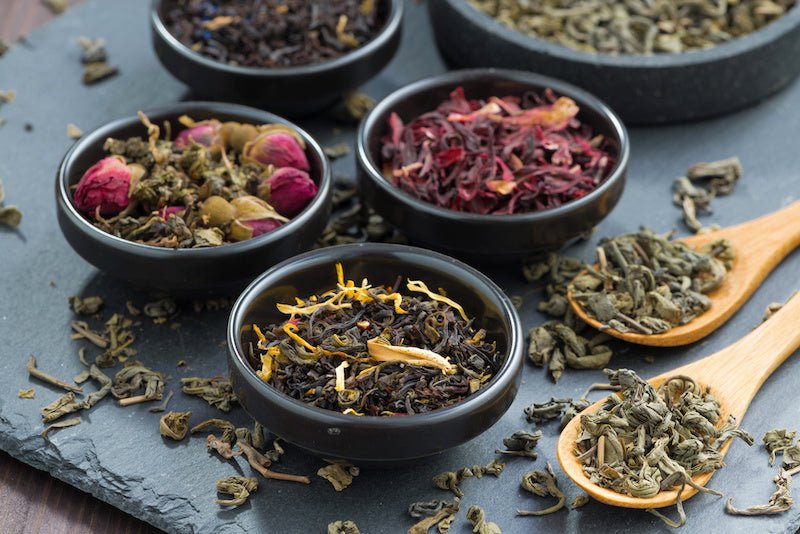In this post, we'll look into all things jasmine tea, its health benefits, and some tips on how to brew the perfect cup. If you're here to learn more about a tea that offers a unique floral flavour and a touch of elegance to tea time, look no further.
Get some water on the boil and let’s get started.
What is jasmine tea?
A better question to start with is ‘what is jasmine?’
Jasmine flowers are typically small, trumpet-shaped, and have a pleasing fragrance that varies in intensity depending on the species and variety. The most well-known species used for their fragrance is jasminum officinale, also known as common jasmine or true jasmine.
'Jasmine tea' usually refers to either white or green tea infused with jasmine flowers which lend a sweetness that balances the natural bitterness of tea leaves. You can also find black tea infusions but it’s less common.

The history of jasmine tea
While the exact origin is disputed, it is believed to have blossomed during China's Song Dynasty, which spanned from the 10th to the 13th century.
Fresh jasmine blossoms are carefully layered over green or white tea leaves during the evening. As night falls, the blossoms open, releasing their sweet aroma, which gently infuses into the tea leaves. This intricate method, passed down through generations has turned jasmine tea into a symbol of elegance and refinement in Chinese tea culture.
The health benefits of jasmine tea
Beyond it being delicious and relaxing to drink, jasmine tea offers potential health benefits. Most of these are covered in our long blog about the health benefits of tea but broadly they include:
Antioxidant properties: Just like earl grey, jasmine tea contains antioxidants, helping combat oxidative stress and reducing the risk of chronic diseases.
Weight management: When camellia sinensis is used as the base, jasmine tea may aid in weight loss by way of suppressing appetite.
Digestive health: Many people drink jasmine tea to promote healthy digestion, by alleviating discomfort after meals.
Heart health: Regular consumption of jasmine tea may contribute to heart health by lowering bad cholesterol. This is more about the tea than the jasmine!
Immune support: The antioxidants in jasmine tea can boost the immune system, helping the body fend off infections.
Skin benefits: Jasmine tea's polyphenols offer skin-protective properties, aiding in maintaining youthful skin.
While drinking jasmine tea to balance out all the bad things you do in your life is unlikely to cure all your ailments, enjoying it as part of a varied diet and active lifestyle is definitely a positive addition.
What does jasmine tea taste like?
If you've enjoyed a lot of jasmine tea over the years and really paid attention to the flavours, you'll likely recognise a lot of the tasting notes below. Every cup can bring something new.
Floral: ‘Floral’ isn’t exactly a highly specific flavour but when you brew a cup you’ll know what we mean. It’s a bit like walking past fresh cut flowers but on your palate rather than in your nose.
Fruity: Jasmine contains Benzyl Acetate - a compound also found in apricots and strawberries.
Citrus: Indole is present in both jasmine and orange blossoms, lending an almost musky aroma synonymous with the smells and flavours of spring.
Sweetness: As mentioned, probably jasmine’s best property for pairing with black and green tea is the honey-sweetness that it brings to the party. Phenylacetaldehyde is present in roses and is found in high concentrations in high quality wild honey.
Mild spice: There is a soft, spicy undertone in jasmine tea that comes from the presence of Hexyl Cinnamaldehyde - a compound found in cinnamon.
How much caffeine is in jasmine tea?

Just like with earl grey, the caffeine content in jasmine tea can vary depending on the base tea (green or white) and the specific blend. Generally, jasmine tea contains less caffeine than black tea or coffee. A 250 ml cup typically contains about 30-40 milligrams of caffeine, which is roughly one-third to one-half the caffeine content of a cup of brewed coffee.
Where does jasmine tea come from?
Jasmine plants naturally thrive in tropical and subtropical regions across Eurasia, Africa, Australasia, and Oceania. Out of the 200 jasmine species, only one is indigenous to Europe.
The majority of jasmine grown for tea comes from China, specifically the provinces of Fujian, Guangxi, and Yunnan.
Other large producers of jasmine tea include Taiwan, Vietnam and Indonesia.
Brewing the perfect cup
Take a bag of Chanui jasmine green for one cup.
Add freshly boiled water.
Infuse for 2-3 minutes. Longer if you like a stronger brew.
Pop the teabag in the compost.
Enjoy!
Did you know?
Legend has it that the practice of drinking jasmine tea began when a little girl was looking for a way to cure her sick brother.
She found a sympathetic dragon who gave her a jasmine bush and told her to look after it through thick and thin.
After caring for the plant, she made tea out of the most delicate blossoms and gave it to her brother.
He was cured and so the legend was born!
Final thoughts
If you’re looking for a new addition to your tea cupboard, look no further that jasmine green. It’s absolutely delicious and really good for you in so many ways.

